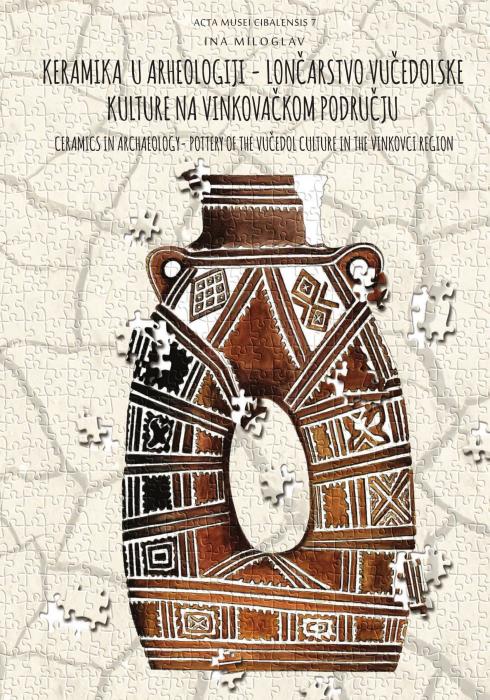Ceramics in Archaeology: Pottery of the Vučedol Culture in the Vinkovci Region
Synopsis
The book is divided into two parts: the first part stems from the author’s position in the Subdepartment of Archaeometry and Methodology at the Department of Archaeology of the Faculty of Humanities and Social Sciences of Zagreb University, where she deals with an aspect of archaeology which is not very popular among archaeologists: counting, classifying and typologically describing tens of thousands of pottery sherds. But, as the author herself put it, We put together pieces of information as if piecing together a jigsaw puzzle, as though we were participating in the creation of the pottery vessels and entering the lives of the people who made them. Pottery is one of the materials most frequently processed and analysed by archaeologists, since it provides infinite and important information about the cultural, social, economic, religious and technological achievements of a community and about the period in which the vessel was made. This part of the book discusses analytical techniques and theoretical frameworks of pottery technology, and parameters for the processing of archaeological pottery. As such, it is very useful and pertinent for any archaeologist dealing with pottery finds as the leading source of archaeological data.
The second part of the book is also interesting to a broader readership, and not just for experts. Much as archaeology is nowadays an interdisciplinary science – which can also be read from Ina Miloglav’s book – we could not imagine reconstructing a landscape or the dietary habits of a population without archaeobotany, while archaeozoology studies animal remains found at archaeological sites. For example, we have learned that, in the period between around 2880–2480 BC, the predominant economic activity of the Vučedol population of Ervenica was animal herding, and that they mostly raised cattle. Many analyses done on sherds of Vučedol pottery have yielded ‘unimaginable’ data on the pottery. The archaeological biomarkers from a cup recovered from Ervenica have revealed residues of milk fat, allowing us to interpret it as a milk cup, while the fat residues on a pottery strainer from Damića Gradina lead to the conclusion that the Vučedol population produced cheese. In addition, petrographic analysis of pottery sherds has shown that the mineral composition of the pottery corresponds to the mineral composition of the loess that Ervenica and Damića Gradina sit on, which confirms that vessels were produced from local raw materials. A standardization test has also been conducted on the pottery material, and its results suggest that the production of pottery was standardized, especially when it comes to a certain type of bowl. On the basis of the results obtained, the author has concluded that the pottery production in these two Vučedol settlements was organized and that it involved specialized potters. (from the Foreword by Maja Krznarić Škrivanko)
Chapters
-
Foreword / Predgovor
-
FIRST PART / PRVI DIO
-
1 Introduction / Uvod
-
2 Archaeometry – archaeology – ethnoarchaeology: interrelated disciplines / Arheometrija-arheologija-etnoarheologija: međusobno povezane discipline
-
3 Origins of pottery / Porijeklo keramičkih posuda
-
4 Pottery paste / Lončarska smjesa
-
5 Physical properties of pottery / Fizičke karakteristike keramike
-
6 Operational sequence in the pottery production process / Lanac operacija u proizvodnom postupku izrade keramičkih posuda
-
7 Parameters for the processing and typological classification of pottery finds / Parametri za obradu i tipološku klasifikaciju keramičkih nalaza
-
8 Methodology of pottery processing / Metodologija obrade keramičkih nalaza
-
SECOND PART / DRUGI DIO
-
9 Processing and analysis of excavated pottery from the site of Ervenica and Damića Gradina / Obrada i analiza keramičkog materijala s lokaliteta na Ervenici i Damića gradini
-
10 Geographical and geological features of the locality / Geografske i geološke značajke krajolika
-
11 Vučedol culture / Vučedolska kultura
-
12 Settlements of the Vučedol culture in Vinkovci and Stari Mikanovci / Naselja vučedolske kulture u Vinkovcima i Starim Mikanovcima
-
13 Typological-statistical analysis / Tipološko-statistička analiza
-
14 Agricultural and economic aspects of the Vučedol settlements / Poljoprivredni i gospodarski segment vučedolskih naselja
-
15 Organic residues in pottery / Organski ostaci u keramičkim posudama
-
16 The clay paste for Vučedol ceramic vessels / Lončarska smjesa vučedolskih posuda
-
17 Product standardization, craft specialization and organization of pottery production / Standardizacija proizvoda, specijalizacija zanata i organizacija keramičke proizvodnje
-
18 Use-related properties and the social context of vučedol pottery / Uporabna svojstva i društveni kontekst vučedolskih posuda
-
List of figures and plates / Popis ilustracija i tabli
-
Bibliography / Literatura
-
About the author / O autorici
-
Excerpts from reviews / Izvatci iz recenzija
-
Plates of drawings of pottery / Table s keramičkim materijalom
Downloads

